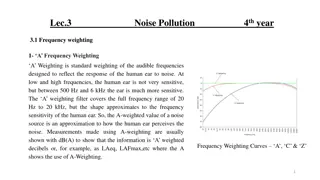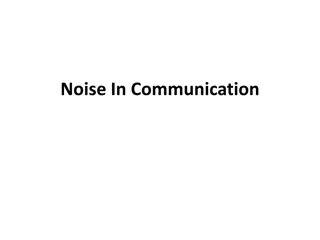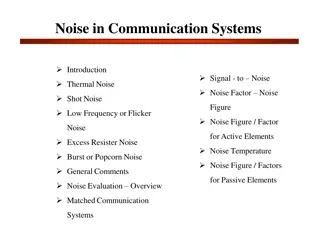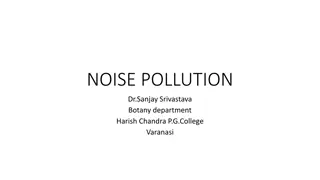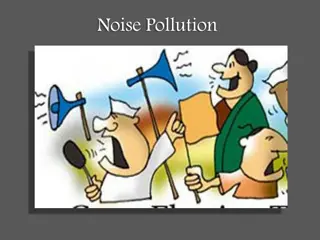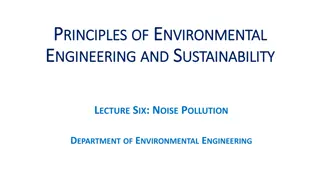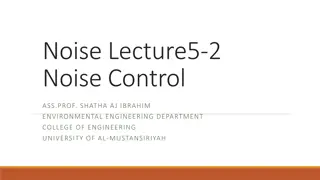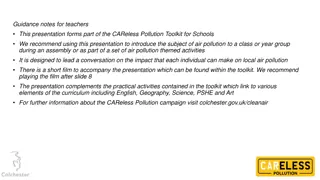Noise Pollution and Its Effects
Noise pollution is the unwanted presence of sound that can have detrimental effects on both humans and animals. As urbanization and industrialization increase, so does the threat of noise pollution. Sources of noise pollution include automobiles, factories, and loudspeakers. It is measured in decibels (dB), with excessive levels causing physiological disturbances. Understanding the properties of noise, such as intensity and frequency, is crucial in managing its impact. Different environments have varying noise levels, with exposure above 85 dB potentially leading to hearing damage. To mitigate noise pollution, it is essential to be aware of acceptable sound levels and frequencies, as well as the potential health risks associated with prolonged exposure.
Download Presentation

Please find below an Image/Link to download the presentation.
The content on the website is provided AS IS for your information and personal use only. It may not be sold, licensed, or shared on other websites without obtaining consent from the author.If you encounter any issues during the download, it is possible that the publisher has removed the file from their server.
You are allowed to download the files provided on this website for personal or commercial use, subject to the condition that they are used lawfully. All files are the property of their respective owners.
The content on the website is provided AS IS for your information and personal use only. It may not be sold, licensed, or shared on other websites without obtaining consent from the author.
E N D
Presentation Transcript
Noise is defined as an unwanted or undesirable sound. The threat of noise pollution is increasing with the rapid pace of urbanization and industrialization. Unwanted sounds not only cause discomfort and irritability to animals but can also lead to physiological disturbances. The noise level can be measured with the help of a sound level meter.
SOURCES SOURCES Automobiles Factories Industries Air-craft Vehicle Horns Loudspeaker Radios Transistors Television etc.
PROPERTIES PROPERTIES The noise has two important properties: loudness or intensity and frequency. Loudness or intensity depends upon the amplitude of the vibrations which initiated the noise. The loudness of noise is measured in decibels (dB). When we say that the sound is-----dB, it means it is-----dB more intense than the smallest distinguishable noise or the reference sound pressure. 0.0002 microbar or dynes/cm2; dyne is 1/1000000thof atmospheric pressure.
A daily exposure up to 85 dB is the tolerable limit without substantial damage of hearing. Normal conversation produces a noise of 60-65 dB. Whispering produces a noise of 20-30 dB. Heavy street traffic produces a noise of 60-80 dB. Boiler factories produces a noise of about 120 dB. In dairies the usual noise levels are found to range between 60-64 decibels. In dairies with fan ventilation the levels may reach more than 80 decibels. In piggeries (especially during feeding) the noise can reach levels of about 100 decibels or more.
Noise level of 50 dB represents calm environment. Noise level of a living room in terms of activity is 40-50 dB. A level of 140 decibel (airplane sound) causes pain in the ear. Excessive sound levels (160-180 dB) may even cause ear damage. In case of humans noise beyond 115 decibels is not permitted. Sound level of 100 decibels for 2 hr and 90 for 8 hr is acceptable.
The frequency of noise is denoted as Hertz (Hz). One Hz is equal to one wave per second. The human ear can hear frequencies from about 20-20,000 Hz. The range of vibrations below 20 Hz is infra- audible and those above 20,000 Hz ultra-sonic. Many animals (dogs) can hear sounds inaudible to the human ear. Sometimes noise is expressed in psycho-acoustic terms- the phon (psyho-acoustic index of loudness). It takes into consideration both intensity and frequency.
INSTRUMENTS USED IN NOISE STUDIES INSTRUMENTS USED IN NOISE STUDIES Sound level meter: Measures intensity of sound in decibel ie. dB or sound pressure levels ie. dB(A). Octave band frequency analyzer: Measures noise in octave bands and resulting plot shows sound spectrum ie. High pitch, low pitch or variable pitch. Audiometer: Measures hearing ability.
EFFECTS OF NOISE EXPOSURE EFFECTS OF NOISE EXPOSURE AUDITORY & NON-AUDITORY Auditory effects: Auditory fatigue (appears at 90 db & greatest at 4000Hz) associated with side effect of whistling and buzzing in ears. Deafness or hearing loss (temporary loss at frequency 4000 6000 Hz and permanent loss at continuous exposure to 100 dB). Permanent loss of hearing is due to inner ear damage ie. minor change in hair cell ending to destruction of organ of corti at 100 dB. Rupture of tympanic membrane on exposure at 160 dB.
Non auditory effect: Interference with speech: most common at frequency 300-400 Hz. Annoyance/irritation Reduce efficiency of work Physiological change: rise in blood pressure, intracranial pressure heart rate, breathing and sweating. Other health effects include giddiness, nausea, fatigue, visual disturbances. stress, hormonal disturbances, cardiovascular problems and muscular rigidity. In poultry the egg production is seriously affected and in animals behaviour may change.
CONTROL OF NOISE CONTROL OF NOISE Careful planning of cities Control of vehicles Improvement in acoustic insulation of building Care in installations of industries and railways Protection of exposed person Legislation Education


